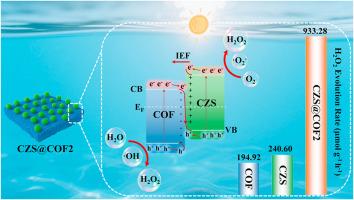在cof - S-scheme异质结中构建π-d界面传导通道以实现太阳能到h2o2的高效转化
IF 14.2
1区 材料科学
Q1 ENGINEERING, MULTIDISCIPLINARY
引用次数: 0
摘要
设计一种高效的光催化系统,能够促进光生成的载流子的快速分离和转移,对于提高过氧化氢(H2O2)的产量至关重要。本文采用共价有机骨架(COF)作为原位生长Cd0.6Zn0.4S (CZS)的平台,形成了一个定义明确的s型异质结。该杂化界面的构建使得COF的离域π-电子与半导体的定域d轨道之间存在强π-d共轭,显著增强了界面电子相互作用,促进了协同电荷转移行为。综合表征,包括原位x射线光电子能谱(XPS)分析,证实了这种电子耦合有效地增强了载流子的分离和迁移。结果,氧还原反应(ORR)明显加快,H2O2产量大幅提高。在可见光照射下,CZS@COF2光催化剂的H2O2生成速率达到933.28 μmol g−1 h−1,比原始COF提高了3.88倍。值得注意的是,即使在没有牺牲剂的纯水中,该催化剂的产率也保持在580.32 μmol g−1的高水平,表明其具有良好的光催化性能。此外,该系统表现出强大的循环稳定性,显示出其强大的可持续和实际应用潜力。本文章由计算机程序翻译,如有差异,请以英文原文为准。

Constructing π-d interfacial conduction channels in COF-based S-scheme heterojunctions for efficient solar-to-H2O2 conversion
Designing an efficient photocatalytic system capable of facilitating rapid separation and transfer of photogenerated charge carriers is pivotal for enhancing hydrogen peroxide (H2O2) production. In this work, a covalent organic framework (COF) was employed as a platform for the in situ growth of Cd0.6Zn0.4S (CZS), leading to the formation of a well-defined S-scheme heterojunction. The construction of this hybrid interface enabled strong π–d conjugation between the delocalized π-electrons of the COF and the localized d-orbitals of the semiconductor, significantly reinforcing interfacial electronic interactions and promoting synergistic charge transfer behavior. Comprehensive characterization, including in situ X-ray photoelectron spectroscopy (XPS) analysis, confirmed that this electronic coupling effectively enhanced charge carrier separation and migration. As a result, the oxygen reduction reaction (ORR) was markedly accelerated, yielding a substantial improvement in H2O2 production. Under visible light irradiation, the CZS@COF2 photocatalyst achieved an impressive H2O2 generation rate of 933.28 μmol g−1 h−1, representing a 3.88-fold enhancement over the pristine COF. Notably, even in pure water without sacrificial agents, the catalyst maintained a high production level of 580.32 μmol g−1, underscoring its excellent photocatalytic performance. Furthermore, the system exhibited robust cycling stability, demonstrating its strong potential for sustainable and practical applications.
求助全文
通过发布文献求助,成功后即可免费获取论文全文。
去求助
来源期刊

Composites Part B: Engineering
工程技术-材料科学:复合
CiteScore
24.40
自引率
11.50%
发文量
784
审稿时长
21 days
期刊介绍:
Composites Part B: Engineering is a journal that publishes impactful research of high quality on composite materials. This research is supported by fundamental mechanics and materials science and engineering approaches. The targeted research can cover a wide range of length scales, ranging from nano to micro and meso, and even to the full product and structure level. The journal specifically focuses on engineering applications that involve high performance composites. These applications can range from low volume and high cost to high volume and low cost composite development.
The main goal of the journal is to provide a platform for the prompt publication of original and high quality research. The emphasis is on design, development, modeling, validation, and manufacturing of engineering details and concepts. The journal welcomes both basic research papers and proposals for review articles. Authors are encouraged to address challenges across various application areas. These areas include, but are not limited to, aerospace, automotive, and other surface transportation. The journal also covers energy-related applications, with a focus on renewable energy. Other application areas include infrastructure, off-shore and maritime projects, health care technology, and recreational products.
 求助内容:
求助内容: 应助结果提醒方式:
应助结果提醒方式:


